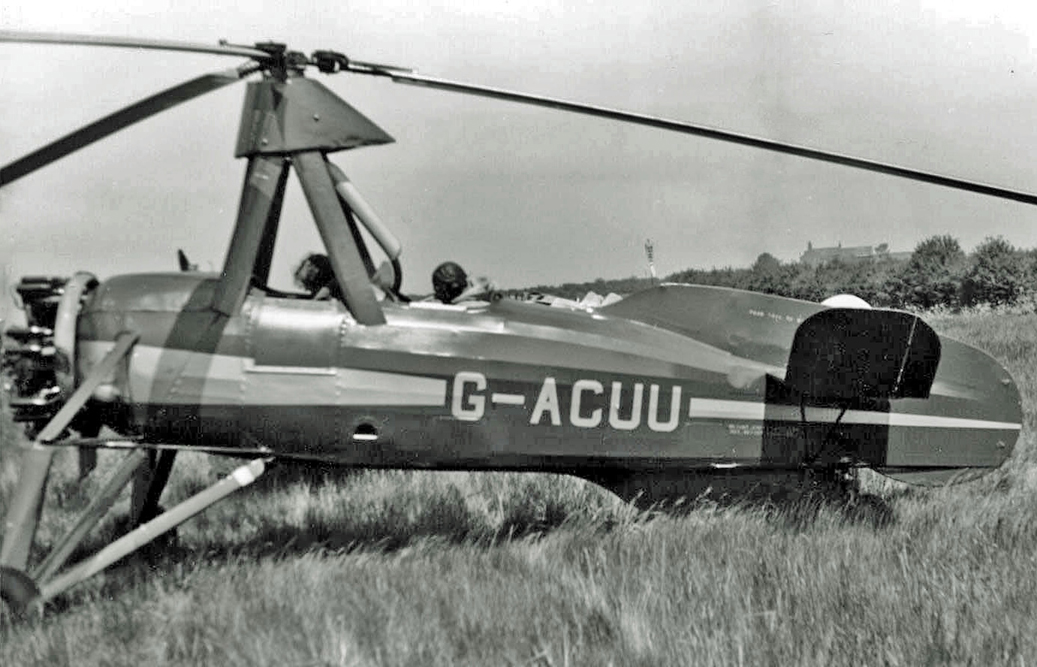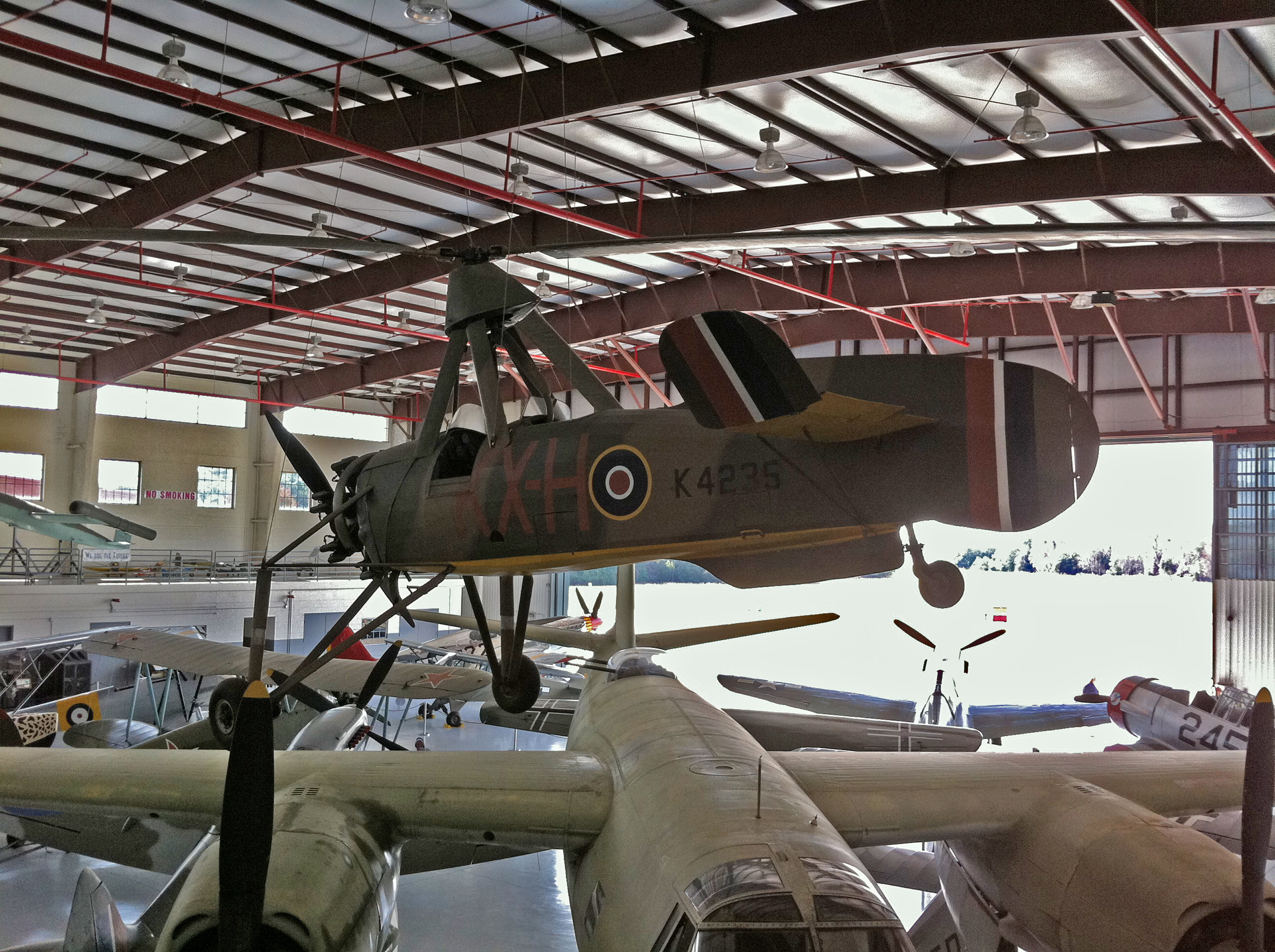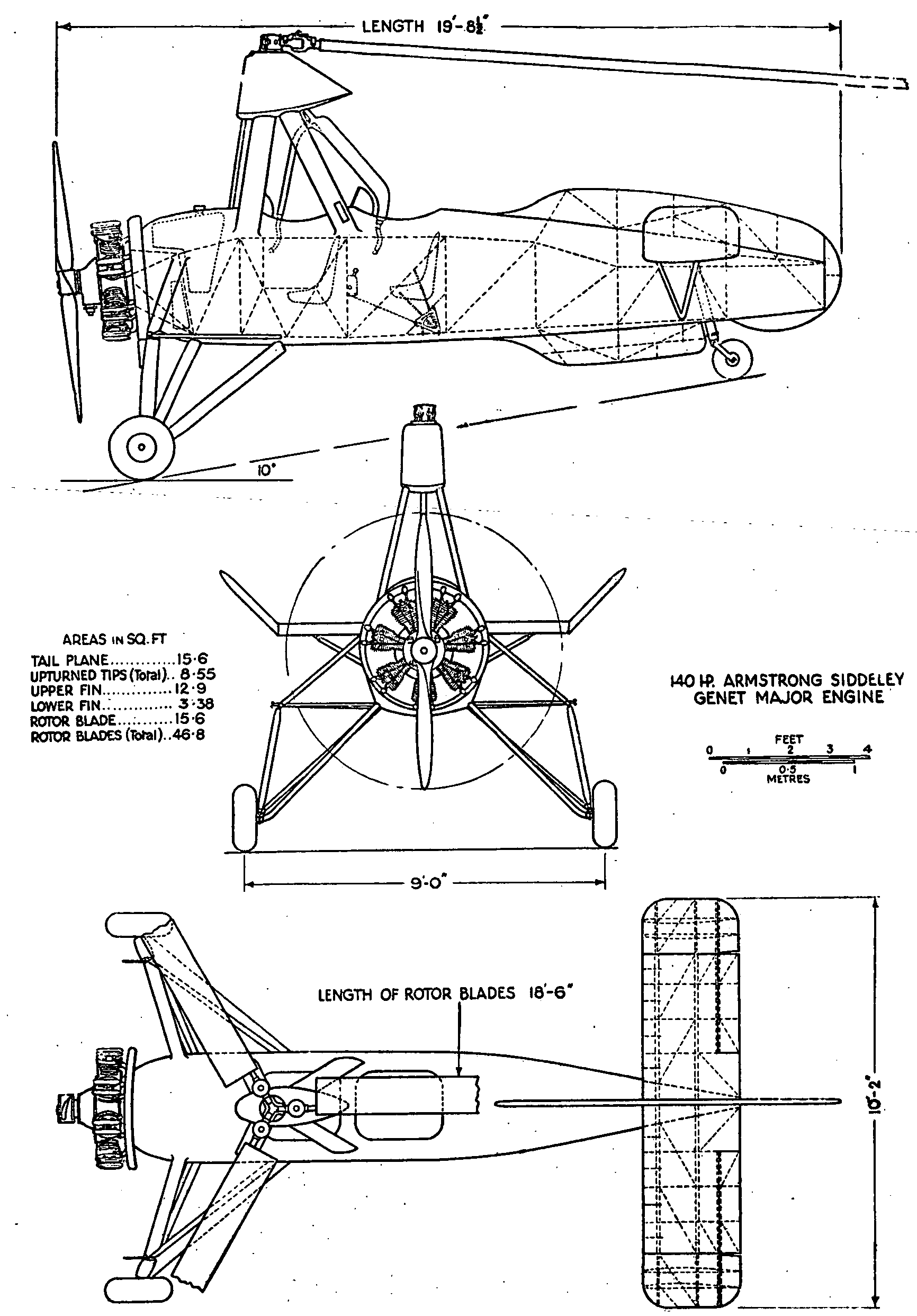Cierva C.30 on:
[Wikipedia]
[Google]
[Amazon]
The Cierva C.30 is an
 The production model, called the C.30A by Avro, was built under licence in Britain, France and Germany and was similar to the C.30P. The main alteration was a further increase in undercarriage track with revised strutting, the uppermost leg having a pronounced knee with wire bracing. There was additional bracing to the
The production model, called the C.30A by Avro, was built under licence in Britain, France and Germany and was similar to the C.30P. The main alteration was a further increase in undercarriage track with revised strutting, the uppermost leg having a pronounced knee with wire bracing. There was additional bracing to the
 ;Argentina
*Cierva C.30A ''LV-FBL'' is on display at the
;Argentina
*Cierva C.30A ''LV-FBL'' is on display at the
Danish Air Museum
/ref> ; * French Air Force *

Spanish reproduction maiden flight
{{RLM aircraft designations C30 Single-engined tractor autogyros 1930s British military utility aircraft 1930s British civil utility aircraft Aircraft first flown in 1933
autogyro
An autogyro (from Greek and , "self-turning"), also known as a ''gyroplane'', is a type of rotorcraft that uses an unpowered rotor in free autorotation to develop lift. Forward thrust is provided independently, by an engine-driven propeller. Whi ...
designed by Juan de la Cierva and built under licence from the Cierva Autogiro Company by A V Roe & Co Ltd (Avro), Lioré-et-Olivier and Focke-Wulf.
Design and development
Before the experimentalCierva C.19
The Cierva C.19 was a 1930s British two-seat autogyro, designed by Spanish engineer Juan de la Cierva. It was built by Avro as the Avro Type 620. It proved to be the most successful and widely produced of the early de la Cierva designs.
Develo ...
Mk V, autogyros had been controlled in the same way as fixed-wing aircraft, that is by deflecting the air flowing over moving surfaces such as ailerons, elevators and rudder. At the very low speeds encountered in autogyro flight, particularly during landing, these controls became ineffective. The experimental machine showed that the way forward was a tilting rotor hub fitted with a hanging stick extending to the pilot's cockpit with which he could change the rotor plane. This was known as direct control and was fitted to the C.30. The production variant, called C.30A in England, was preceded by several development machines.
The first production design in the series was the C.30, a radial-engined autogyro with a three-blade, 37 ft (11.3 m) rotor mounted on an aft-leaning tripod, the control column extending into the rear of the two cockpits. The engine was the five-cylinder, 105 hp (78 kW) Armstrong Siddeley Genet Major I used in the C.19 series. The fabric-covered fuselage carried an unbraced tailplane, without elevators but with turned-up tips. The port side of the tailplane had an inverted aerofoil section to counter roll-axis torque produced by the propeller. As with most autogyros, a high vertical tail was precluded by the sagging resting rotor, so the dorsal fin was long and low, extending well aft of the tailplane like a fixed rudder and augmented by a ventral fin. The wide-track undercarriage had a pair of single, wire-braced legs and a small tail wheel was fitted. This model flew in April 1933. It was followed by four improved machines designated C.30P (P here for pre-production) which differed in having a four-legged pyramid rotor mounting and a reinforced undercarriage with three struts per side. The rotor could be folded rearwards for transport. The C.30P used the more powerful (140 hp, 104 kW) seven-cylinder Armstrong Siddeley Genet Major IA radial engine.
 The production model, called the C.30A by Avro, was built under licence in Britain, France and Germany and was similar to the C.30P. The main alteration was a further increase in undercarriage track with revised strutting, the uppermost leg having a pronounced knee with wire bracing. There was additional bracing to the
The production model, called the C.30A by Avro, was built under licence in Britain, France and Germany and was similar to the C.30P. The main alteration was a further increase in undercarriage track with revised strutting, the uppermost leg having a pronounced knee with wire bracing. There was additional bracing to the tailplane
A tailplane, also known as a horizontal stabiliser, is a small lifting surface located on the tail (empennage) behind the main lifting surfaces of a fixed-wing aircraft as well as other non-fixed-wing aircraft such as helicopters and gyropla ...
and both it and the fin carried small movable trimming surfaces. Each licensee used nationally built engines and used slightly different names. In all, 143 production C.30s were built, making it by far the most numerous pre-war autogyro.
Between 1933 and 1936, de la Cierva used one C.30A (''G-ACWF'') to test his last contribution to autogyro development before his death in the crash of a KLM
KLM Royal Dutch Airlines, legally ''Koninklijke Luchtvaart Maatschappij N.V.'' (literal translation: Royal Aviation Company Plc.), is the flag carrier airline of the Netherlands. KLM is headquartered in Amstelveen, with its hub at nearby Amste ...
Douglas DC-2 airliner at Croydon Airfield in England on 9 December 1936. To enable the aircraft to take off without forward ground travel, he produced the "autodynamic" rotor head, which allowed the rotor to be spun up by the engine in the usual way but to higher than take-off r.p.m at zero rotor incidence and then to reach operational positive pitch suddenly enough to jump some 20 ft (6 m) upwards.
At least one Royal Air Force
The Royal Air Force (RAF) is the United Kingdom's air and space force. It was formed towards the end of the First World War on 1 April 1918, becoming the first independent air force in the world, by regrouping the Royal Flying Corps (RFC) an ...
(RAF) C.30A was on floats as a Sea Rota in January 1935.
Production
;Avro Avro obtained the licence in 1934 and subsequently built 78 examples, under their model designation, fitted with an Armstrong Siddeley Genet Major IA (known in the RAF as the Civet 1) 7-cylinder radial engine producing . The first production C.30A was delivered in July 1934. ;Lioré-et-Olivier Twenty-five aircraft were built in France by Lioré-et-Olivier as the LeO C.301 with a 175 hp (130 kW) Salmson 9NE 9-cylinder radial engine. ;Focke-Wulf Forty aircraft were built in Germany as the Focke-Wulf Fw 30 Heuschrecke (Grasshopper) with a 140 hp (105 kW)Siemens Sh 14A
The Siemens-Halske Sh 14 was a seven-cylinder air-cooled radial engine for aircraft produced in Germany in the 1920s and 1930s. First run in 1928, it was rated at 93 kW (125 hp).
Applications
* Albatros L 82
* Ambrosini SAI.3
* Amb ...
7-cylinder radial engine.
Operational history
Of the 66 non-RAF aircraft built in the UK by Avro, 37 appeared at least for a while on the UK register. Some (maybe a dozen) were sold abroad, but others were flown by wealthy enthusiasts and by flying clubs who offered autogyro training. By the end of the decade, private flyers were moving back to the comforts and economies of fixed-wing aircraft and more C.30s moved abroad leaving the Autogyro Flying Club at London Air Park, Hanworth as the major UK user. 26 aircraft were directly exported by Avro. These went both to private owners and to foreign air forces who wish to investigate the autogyro's potential. In 1934, one Spanish Navy C.30 piloted by Cierva landed on the Spanish Seaplane tender ''Dedalo'' anchored inValencia
Valencia ( va, València) is the capital of the autonomous community of Valencia and the third-most populated municipality in Spain, with 791,413 inhabitants. It is also the capital of the province of the same name. The wider urban area al ...
harbor and later made a takeoff.
In September 1935, five members of the Lithuanian Aero Club flew C.30A in the "air train" together with the glider Schneider Grunau Baby and the airplane de Havilland DH.60 Moth
The de Havilland DH.60 Moth is a 1920s British two-seat touring and training aircraft that was developed into a series of aircraft by the de Havilland Aircraft Company.
Development
The DH.60 was developed from the larger DH.51 biplane ...
over the Baltic sea states: Kaunas, Riga, Tallinn
Tallinn () is the most populous and capital city of Estonia. Situated on a bay in north Estonia, on the shore of the Gulf of Finland of the Baltic Sea, Tallinn has a population of 437,811 (as of 2022) and administratively lies in the Harju '' ...
, Helsinki
Helsinki ( or ; ; sv, Helsingfors, ) is the capital, primate, and most populous city of Finland. Located on the shore of the Gulf of Finland, it is the seat of the region of Uusimaa in southern Finland, and has a population of . The city ...
.
Twelve C.30As built by Avro for the Royal Air Force (RAF) entered service as the Avro 671 Rota Mk 1 ( Serials ''K4230'' to ''K4239'' and ''K4296'' & ''K4775''). The twelve were delivered between 1934 and 1935. They equipped the School of Army Co-operation
The School of Land/Air Warfare was a Royal Air Force school based at Old Sarum in Wiltshire. Its purpose was to encourage greater co-operation between officers in the air and those on the ground.
History
The School was originally established at ...
at RAF Old Sarum
Old Sarum Airfield is a grass strip airfield north-north-east of Salisbury, Wiltshire, England.
The adjacent areas are a mix of vacant land, residential and industrial sites. Residential areas are to the south and east, occupying the old air ...
near Salisbury.
Many of the surviving civil aircraft were also taken into RAF service between 1939 and 1940. In 1940 they equipped 1448 Flt. at RAF Duxford
Duxford Aerodrome is located south of Cambridge, within the civil parish of Duxford, Cambridgeshire, England and nearly west of the village. The airfield is owned by the Imperial War Museum (IWM) and is the site of the Imperial War Mus ...
. Later they equipped 529 Sqn. at RAF Halton on radar
Radar is a detection system that uses radio waves to determine the distance ('' ranging''), angle, and radial velocity of objects relative to the site. It can be used to detect aircraft, ships, spacecraft, guided missiles, motor vehicles, we ...
calibration work, disbanded in October 1945, the twelve survivors were sold on to civilian owners.
Most of these did not last long, although two were used for pilot rotary wing experience by Fairey in their Fairey Gyrodyne helicopter programme. Rota Towels kept one ex-RAF Rota airworthy ''G-AHTZ'' until an accident in 1958. ''G-ACUU'', the Imperial War Museum's C.30A exhibit at Duxford
Duxford is a village in Cambridgeshire, England, about south of Cambridge. It is part of the Hundred Parishes area.
History
The village formed on the banks of the River Cam, a little below its emergence from the hills of north Essex. One of t ...
had one of the longest active lives. It joined Air Service Training Ltd in 1934, was impressed (as Rota ''HM580'') in 1942, serving with 529 Squadron and returning to civil use by G.S. Baker based at Birmingham's Elmdon Airport airport with its original registration plus the nickname ''Billy Boy'' and was not withdrawn from use until 1960.
After several years of work at the Maestranza Aérea de Albacete, on 15 January 1998, a C.30 was flown again. It was piloted by Lieutenant Colonel Fernando Iglesia. After an accident in June 2000, which almost left the pilot without an arm, the aircraft was handed over to the Museum of Aeronautics and Astronautics, located at the Cuatro Vientos air base (Madrid).
Variants
;C.30: Powered by a Armstrong Siddeley Genet Major I radial piston engine. ;C.30P: Improved model, powered by a Armstrong Siddeley Genet Major IA radial piston engines ;C.30A: Main production model, powered by a Armstrong Siddeley Genet Major IA radial piston engine. ;Rota Mk I: RAF designation of the Cierva C.30A. ;Lioré et Olivier LeO C-30: 59 license built Cierva C.30, powered by Salmson 9Ne engines, were supplied to the French Air Force andFrench Navy
The French Navy (french: Marine nationale, lit=National Navy), informally , is the maritime arm of the French Armed Forces and one of the five military service branches of France. It is among the largest and most powerful naval forces in t ...
. All LeO C-30 autogyros were destroyed or captured by German forces during the invasion of France in 1940.
;Lioré et Olivier LeO C-30S: Construction number 26 was completed as the sole C-30S.
;Lioré-et-Olivier LeO C-301: Improved C-30s with uprated Messier oleo-pneumatic shock absorbers, flotation devices to facilitate ditching at sea and tripod main rotor support. Six aircraft were delivered to the French Navy by early June 1940.
;Lioré et Olivier LeO C-302:Early autogyros suffered from relatively long take-off runs. To reduce the take-off length two C-301 aircraft were fitted with the equivalent of Cierva's "Jump" head allowing the aircraft to leap vertically after only a very short run. The C-302s were used extensively for testing rotor and undercarriage components but development was eventually abandoned in 1949/1950.
;Focke-Wulf C 30 Heuschrecke: (''Heuschrecke'' (Grasshopper)): 40 aircraft built, each with a Siemens Sh 14A
The Siemens-Halske Sh 14 was a seven-cylinder air-cooled radial engine for aircraft produced in Germany in the 1920s and 1930s. First run in 1928, it was rated at 93 kW (125 hp).
Applications
* Albatros L 82
* Ambrosini SAI.3
* Amb ...
7-cylinder radial engine.
Aircraft on display
Museo Nacional de Aeronáutica de Argentina
The National Aeronautics Museum "Brigadier Edmundo Civati Bernasconi" ( es, Museo Nacional de Aeronáutica) is an Argentine museum located in the city of Morón, Buenos Aires. Established in 1960, the museum is dedicated to the history of aviati ...
.
;Australia
*Cierva C.30A ''VH-USR'' is on display at the Powerhouse Museum
The Powerhouse Museum is the major branch of the Museum of Applied Arts & Sciences (MAAS) in Sydney, the others being the historic Sydney Observatory at Observatory Hill, and the newer Museums Discovery Centre at Castle Hill. Although often de ...
, Sydney.
;France
*Leo C-302 ''F-BDAD'' is on display at the Musée de l'Air et de l'Espace, Paris.
;Italy
*Cierva C.30 ''I-CIER'' is on display at the Museo della Scienza e della Tecnologia "Leonardo da Vinci", Milan.
;Netherlands
*Cierva C.30A ''SE-AFI'' is on display at the Aviodrome.
;Spain
*Cierva C.30A ''XVU.1-1'' flyable reproduction with a Siemens engine is on display at Museo del Aire, Madrid.
;United Kingdom
*Avro Rota I ''K4232'' on display at the Royal Air Force Museum
The Royal Air Force Museum is a museum dedicated to the Royal Air Force in the United Kingdom. The museum is a non-departmental public body of the Ministry of Defence and is a registered charity.
The museum is split into two separate sites:
* ...
, London, England.
*Cierva C.30A ''AP506'' (smashed wreck) on display at the Helicopter Museum, Weston-super-Mare
Weston-super-Mare, also known simply as Weston, is a seaside town in North Somerset, England. It lies by the Bristol Channel south-west of Bristol between Worlebury Hill and Bleadon Hill. It includes the suburbs of Mead Vale, Milton, Oldmix ...
, England.
*Cierva C.30A ''AP507'' on display at the Science Museum
A science museum is a museum devoted primarily to science. Older science museums tended to concentrate on static displays of objects related to natural history, paleontology, geology, industry and industrial machinery, etc. Modern trends in ...
in London, England.
*Avro Rota I ''HM580'' the former ''G-ACUU'' is on display at the Imperial War Museum Duxford
Imperial War Museum Duxford is a branch of the Imperial War Museum near Duxford in Cambridgeshire, England. Britain's largest aviation museum, Duxford houses the museum's large exhibits, including nearly 200 aircraft, military vehicles, artill ...
, England.
;United States
*Cierva C.30A ''K4235'' on display at Fantasy of Flight
Fantasy of Flight is an aviation museum in Polk City, Florida.
It opened in November 1995, to house Kermit Weeks' collection of aircraft that, until Hurricane Andrew damaged many in 1992, were housed at the Weeks Air Museum in Tamiami, Florid ...
, Polk City, Florida.
Military operators
; *Royal Danish Air Force
The Royal Danish Air Force ( da, Flyvevåbnet, lit=The Flying weapon) (RDAF) is the aerial warfare force of The Kingdom of Denmark and one of the four branches of the Danish Defence. Initially being components of the Army and the Navy, it was ...
/ref> ; * French Air Force *
French Naval Aviation
French Naval Aviation (often abbreviated in French to: ''Aéronavale'' (contraction of Aéronautique navale), or ''Aviation navale'', or more simply ''l'Aéro'') is the naval air arm of the French Navy. The long-form official designation is ' ...
;
*Royal Air Force
The Royal Air Force (RAF) is the United Kingdom's air and space force. It was formed towards the end of the First World War on 1 April 1918, becoming the first independent air force in the world, by regrouping the Royal Flying Corps (RFC) an ...
** No. 80 Squadron RAF
**No. 529 Squadron RAF
No. 529 Squadron RAF was a radar calibration unit of the Royal Air Force during World War II. The unit had the distinction to be the only RAF unit to fly autogyros and helicopters operationally during World War II.
History
No. 529 Squadron was f ...
Specifications (C.30A)

References
Notes
Bibliography
* Barratt, M. "Talkback". ''Air Enthusiast
''Air Enthusiast'' was a British, bi-monthly, aviation magazine, published by the Key Publishing group. Initially begun in 1974 as ''Air Enthusiast Quarterly'', the magazine was conceived as a historical adjunct to ''Air International'' maga ...
'' No. 107, September/October 2003. p. 75.
*
*
*
*
*
*
*
*
*
External links
Spanish reproduction maiden flight
{{RLM aircraft designations C30 Single-engined tractor autogyros 1930s British military utility aircraft 1930s British civil utility aircraft Aircraft first flown in 1933